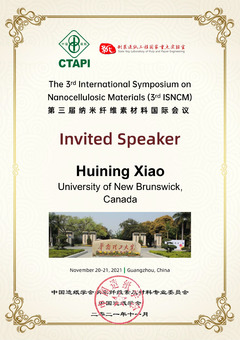
Conference Guide(参会指南): https://isncm2021.aconf.org/news.html
November 19-21, 2021 | Guangzhou, China

Start Time:2021-11-21 08:30 (Asia/Shanghai)
Duration:25min
Session:[SC] The 3rd International Symposium on Nanocellulosic Materials-Oral Session (ROOM 3) » [S6] Oral Session 13 & 14
Tips: The file permissions under this presentation are private. You have not logged in yet and cannot view it temporarily.

Dr. Xiao, a Professor in Chemical Engineering at the University of New Brunswick (UNB) and the Fellow of Canadian Academy of Engineering, obtained his Ph.D in Chemical Engineering at McMaster University in Canada in 1995. Before joining the UNB in 2001, he was a Lecturer at the University of Manchester in the UK from 1996 to 2001. Prof. Xiao’s research interests mainly cover the functional modification of cellulose including micro- or nanofibrillated cellulose with polymers and nanoparticles; enhancing multi-barrier properties of fibre networks for green-based packaging and foam materials; green-based bioadsorbents for water purification and soil remediation; antiviral/antibacterial-modified cellulose and nonwoven textiles; and smart carriers for controlled release of drugs and agrochemicals. To date Dr. Xiao has published over 320 SCI peer-reviewed journal papers. Since joining the UNB, he has supervised or co-supervised more than 30 PhD students and over 20 PDFs. The PhD students/PDFs under his supervision have also won various prestigious awards including the recipients of CRC Tie 2 in Canada and the National Science Fund of China for distinguished young scholars.
Comment submit